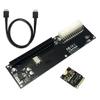Voltage Compatibility】
When using electrical appliances, please note that they are designed for Japanese voltage specifications (90-110V), so if you use them with a different voltage, it may cause a malfunction.
【Plug Type】
Our products use Japanese plug types (A or B type).
Please use a conversion adapter if necessary.
【Important Note on Transformers and Adapters】
A transformer adjusts voltage to match your device’s requirements.
A conversion adapter only changes the plug shape and does not adjust voltage.
Using only a conversion adapter without a transformer may result in damage to the product.
【Liability】
We are not responsible for malfunctions or damages caused by improper use, such as operating the product without a transformer.
Miniature PC style case for Raspberry Pi 5. NVMe M.2 SSD shield supports 2230 and 2242 sizes, providing expanded storage and ultra-fast response.
**SSD Compatibility and Setup Information: Check the product description for SSD compatibility or search "Pi Benchmark" online. Instructions for setting up your boot drive are also included in the product description below. You can also follow the official Raspberry Pi documentation and online tutorials.
With easy access to GPIO pins, a colored side door for quick SSD swapping, and beautifully showcasing the interior RGB lighting, it combines style and functionality.
Features an RGB-lit PWM fan that lights up with system power and automatically adjusts speed based on CPU temperature (*Note: lighting is not programmable and fan may not spin when CPU is cold or run continuously when no OS or bootable drive is present).
Easily power your Raspberry Pi 5 on and off from outside the case with the convenient side power button that connects directly to the Raspberry Pi 5's power button.
Customize your front panel to create a unique case. The frame is designed to support a variety of materials, including 1/16–1/8 inch (1.6-3mm) acrylic, wood, and PCB boards, with a personalized style.
Raspberry Pi 5 NVMe SSD HAT - Compatibility Notice: This NVMe SSD HAT for Raspberry Pi 5 shares the same circuit design as the widely adopted M.2 HAT. It features a minimally customized PCB layout to fit your case dimensions. Like the official Raspberry Pi Foundation M.2 HAT, it only supports 2230 and 2242 NVMe SSDs.
If your SSD is not recognized or cannot boot with Raspberry Pi 5, it may be due to the incompatibility of your SSD with Raspberry Pi 5. The HAT simply acts as a signal and power bridge and does not affect the compatibility of your SSD.
SSD controllers that are known to cause issues:
SMI2263XT, SMI2263EN, MAP1202, Phison series controllers.
★ Known incompatible SSDs ★
The SSDs that are reported to have compatibility issues with the Raspberry Pi 5 are:
Inland TN446. Corsair MP600. Micron 2450. Kingston OM8SEP4256Q-A0. WD Blue SN550 / SN580. WD Green SN350. WD Black SN850 / SN770. Kingspec series SMI2263XT, SMI2263EN, MAP1202, or any other SSD using the Phison series controllers.
★ Recommended SSD (compatibility confirmed) ★
The following SSDs are known for their low power consumption and low heat, making them a perfect fit for the Raspberry Pi 5 hardware and power limitations:
Samsung PM9A1, PM981, PM991, PM991a, PM9B1. SK hynix BC901, BC711. Kioxia BG4, BG5 (2230 size) Raspberry Pi NVMe official SSD.
★ Tips for stable operation ★
Make sure your Raspberry Pi 5 has the latest bootloader and OS. Before purchasing an SSD, we recommend searching "Pi Benchmarks" online to see real-world performance and compatibility reports.
☘ How to set up SSD boot on Raspberry Pi 5 using M.2 HAT
Note: The boot settings for SSD are the same as the official M.2 HAT or other standard models.
Follow the official Raspberry Pi documentation and online tutorials.
Or see the step-by-step guide below:
1. Assemble the Raspberry Pi 5 board with the M.2 HAT and SSD.
2. Insert the SD card with Raspberry Pi OS into the Raspberry Pi 5 and power it on.
3. Open a terminal and run the following commands one by one to update your Raspberry Pi:
sudo apt update && sudo apt full upgrade.
sudo apt install rpi-eeprom.
sudo rpi-eeprom-update.
4. Install Raspberry Pi Imager:
sudo apt install rpi-imager.
5. Run Raspberry Pi Imager:
rpi-imager.
6. About Images:
- Select Raspberry Pi 5 as your device.
- Select your OS version.
- Select the SSD as the target drive and begin the installation.
7. After the OS is installed, set the boot order by doing the following:
sudo raspi-config.
8. Set the boot order:
Advanced options → Boot Order → NVMe/USB Boot
Then press the "Done" or "Escape" key.
9. Reboot your Raspberry Pi. It will boot from the NVMe SSD 💕







![ElectroCookie Mini PC Case for Raspberry Pi 5 NVMe SSD PCIe HAT Active RGB Lighting Cooler Case HAT M.2 & (Black + M.2 [ECR5 SSDS])](https://img.joomcdn.net/b8c4840c305464e7d1a4826e5af7fb6b8c1fcb4f_1024_819.jpeg)
![ElectroCookie Mini PC Case for Raspberry Pi 5 NVMe SSD PCIe HAT Active RGB Lighting Cooler Case HAT M.2 & (Black + M.2 [ECR5 SSDS])](https://img.joomcdn.net/90f94e3bcd4da32c5984f8c425be62d5bb3ea318_1024_1024.jpeg)
![ElectroCookie Mini PC Case for Raspberry Pi 5 NVMe SSD PCIe HAT Active RGB Lighting Cooler Case HAT M.2 & (Black + M.2 [ECR5 SSDS])](https://img.joomcdn.net/ff5cb8606d699babd8fb32457ec24492586543e1_1024_1024.jpeg)
![ElectroCookie Mini PC Case for Raspberry Pi 5 NVMe SSD PCIe HAT Active RGB Lighting Cooler Case HAT M.2 & (Black + M.2 [ECR5 SSDS])](https://img.joomcdn.net/94e4de58ed13e4ac190330a73823d8469ae86204_1024_1024.jpeg)
![ElectroCookie Mini PC Case for Raspberry Pi 5 NVMe SSD PCIe HAT Active RGB Lighting Cooler Case HAT M.2 & (Black + M.2 [ECR5 SSDS])](https://img.joomcdn.net/6c0c313dd5543065a094c4d354ad761bc26ea609_1024_1024.jpeg)
![ElectroCookie Mini PC Case for Raspberry Pi 5 NVMe SSD PCIe HAT Active RGB Lighting Cooler Case HAT M.2 & (Black + M.2 [ECR5 SSDS])](https://img.joomcdn.net/a25f19710f08beef63bc0c6d60d1a5cbc9efd80d_1024_1024.jpeg)
![ElectroCookie Mini PC Case for Raspberry Pi 5 NVMe SSD PCIe HAT Active RGB Lighting Cooler Case HAT M.2 & (Black + M.2 [ECR5 SSDS])](https://img.joomcdn.net/00c80bb0e773b88b6a81c8453606f60034f9e6a5_1024_1024.jpeg)
![ElectroCookie Mini PC Case for Raspberry Pi 5 NVMe SSD PCIe HAT Active RGB Lighting Cooler Case HAT M.2 & (Black + M.2 [ECR5 SSDS])](https://img.joomcdn.net/24d8aa5d0c53f5621ce7082f6d4b32b6a7f76b8d_1024_1024.jpeg)
![ElectroCookie Mini PC Case for Raspberry Pi 5 NVMe SSD PCIe HAT Active RGB Lighting Cooler Case HAT M.2 & (Black + M.2 [ECR5 SSDS])](https://img.joomcdn.net/26df79dd748cf3d5639bbbfe77f9a57ddc4bb2e6_1024_819.jpeg)


















